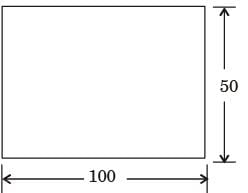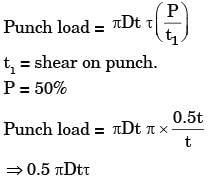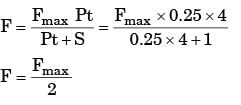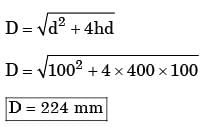Past Year Questions: Sheet Metal Operations - Mechanical Engineering MCQ
30 Questions MCQ Test - Past Year Questions: Sheet Metal Operations
The thickness of the blank needed to produce, by power spinning a missile cone of thickness 1.5 mm and half cone angle 30°
[ME 1992]
A 50 mm diameter disc is to be punched out from a carbon steel sheet 1.0 mm thick. The diameter of the die should be (Take clearance as 3% of sheet thickness) _______.
[ME 1996]
The cutting force in punching and blanking operations mainly depends on
[ME 2001]
In blanking operation the clearance is provided on
[ME 2002]
A metal disc of 20 mm diameter is to be punched from a sheet of 2 mm thickness. The punch and the dia clearance is 3%. The required punch diameter is
[ME 2003]
10 mm diameter holes are to be punched in a steel sheet of 3 mm thickness. Shear strength of the material is 400 N/mm2 and penetration is 40%. Shear provided on the punch is 2 mm.The blanking force during the operation will be
[ME 2004]
The shear strength of a sheet metal is 300 MPa.The blanking force required to produce a blank of 100 mm diameter from a 1.5 mm thick sheet is close to
[ME 2011]
Calculate the punch size in mm, for a circular blanking operation for which details are given below.
Size of the blank - 25 mm
Thickness of the sheet - 2 mm
Radial clearance between punch and die 0.06 mm Die allowance 0.05 mm
[ME 2012]
A rectangular hole of size 100 mm × 50 mm is to be made on a 5 mm thick sheet of steel having ultimate tensile strength and shear strength of 500 MPa and 300 MPa, respectively. The hole is made by punching process. Neglecting the effect of clearance, the punching force (in kN) is
[ME 2014,Set-2]
Internal gears are manufactured by
[ME 2014,Set-2]
Calculate the smallest punch diameter that can be designed for piercing sheet metal strip with the following data. Crushing strength of the punch material is 1500 MPa. Thickness of the sheet is 2 mm, factor of safety is 3, shear strength of the sheet material 500 MPa is
[PI 1990]
In blanking operation, the best way to improve the smoothness and secureness of the edges is to
[PI 1994]
For 50% penetration of work material, a punch with single shear equal to thickness will
[PI 2001]
Which one is not a method of reducing cutting forces to prevent the overloading of press?
[PI 2003]
A hydraulic press is used to produce circular blanks of 10 mm diameter from a sheet of 2 mm thickness. If the shear strength of the sheet material is 400 N/mm2, the force required for producing a circular blank is
[PI 2003]
Consider the following statements related piercing and blanking
1. Shear on the punch reduces the maximum cutting force
2. Shear increases the capacity of the press needed
3. Shear increases the life of the punch
4. Total energy needed to make the cut remains unaltered due to provision of shear.
Which of the above statements are correct?
[PI 2003]
A cylindrical cup of 48.5 mm diameter and 52 mm height has a corner radius of 1.5 mm.Cold rolled steel sheet of thickness 1.5 mm is used to produce the cup. Assume trim allowance as 2 mm per 25 mm of cup diameter.What is the blank size in mm?
[PI 2004]
A hole of 40 mm diameter is pierced in a steel sheet of 4 mm thickness without shear on the tool. Shear strength of steel is 400 N/mm2 and penetration is 25%. What is the expected percentage load reduction if a shear of 1 mm is provided on the punch?
[PI 2004]
Determine the load required to punch a 20 mm diameter hole in 2 mm thick sheet. The properties of the material of the sheet are: Tensile strength – 580 MPa
Yield strength in tension – 410
MPa Shear strength – 350 MPa
Yield strength in shear – 250 MPa
The load in kN is
[PI 2004]
A ϕ 25 mm hole is pierced in a t = 2.5 mm thick steel sheet having shear strength τ = 350 MPa.If the diametral clearance is given by the expression c = 0.0064 √τ, the die diameter (in mm), punch diameter (in mm) and punch force in (kN) respectively are
[PI 2005]
It is require to punch a hole of diameter 10 mm on a sheet of thickness 3 mm. The shear strength of the work material is 420 MPa. The required punch force is
[PI 2006]
It is required to punch a hole of diameter 10 mm on a sheet of thickness 3 mm. The shear strength of the work material is 420 MPa.The required punch force is
[PI 2006]
Circular blanks of 35 mm dia are punched from a steel sheet of 2 mm thickness. If the clearance per side between the punch and die is to be kept as 40 microns. The sizes of punch and die should respectively be
[PI 2007]
A blank of 50 mm diameter is to be sheared from a sheet of 2.5 mm thickness. The required radial clearance between the die and the punch is 6% of sheet thickness. The punch and die diameter (mm) for this blanking operation respectively are
[PI 2008]
A disc of 200 mm diameter is blanked from a strip of an aluminum alloy of thickness 3.2 mm.The material shear strength to fracture is 150 MPa.The blanking force (in kN) is
[PI 2009]
Circular blanks of 10 mm diameter are punched from an aluminum sheet of 2 mm thickness.The shear strength of aluminum is 80 MPa.The minimum punching force required in kN is
[PI 2013]
Wrinkling is a common defect found is
[ME 1991]
In deep drawing of sheets, the values of limiting drawing ratio depends on
[ME 1994]
Identify the stress strain in flange portion of a partially drawn cylindrical cup when deep drawing without a blank holder
[ME 1999]
A shell of 100 mm diameter and 100 mm height with the corner radius of 0.4 mm is to be produced by cup drawing. The required blank diameter is
[ME 2003]

























